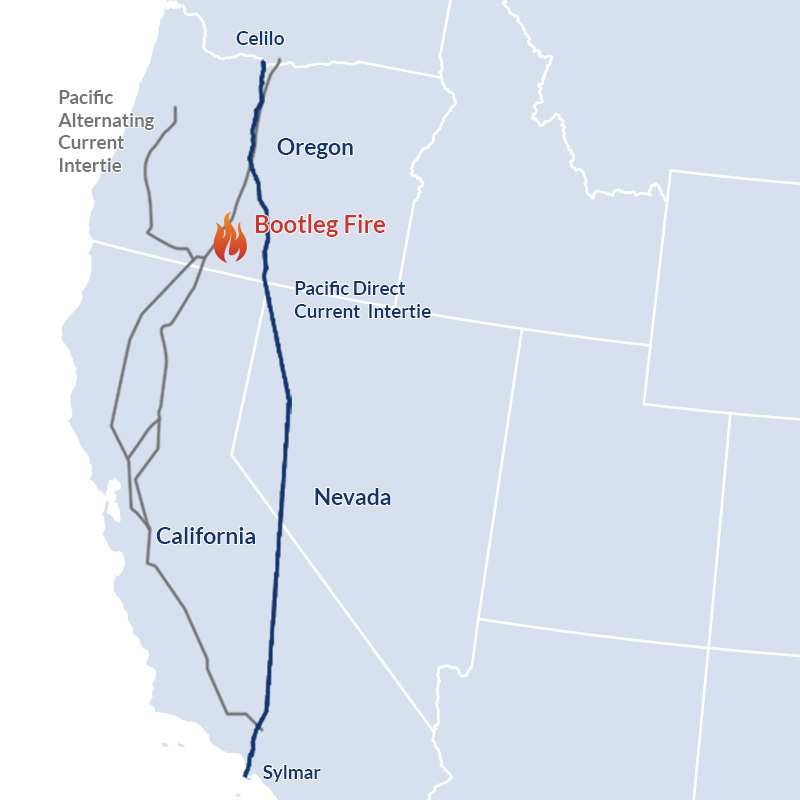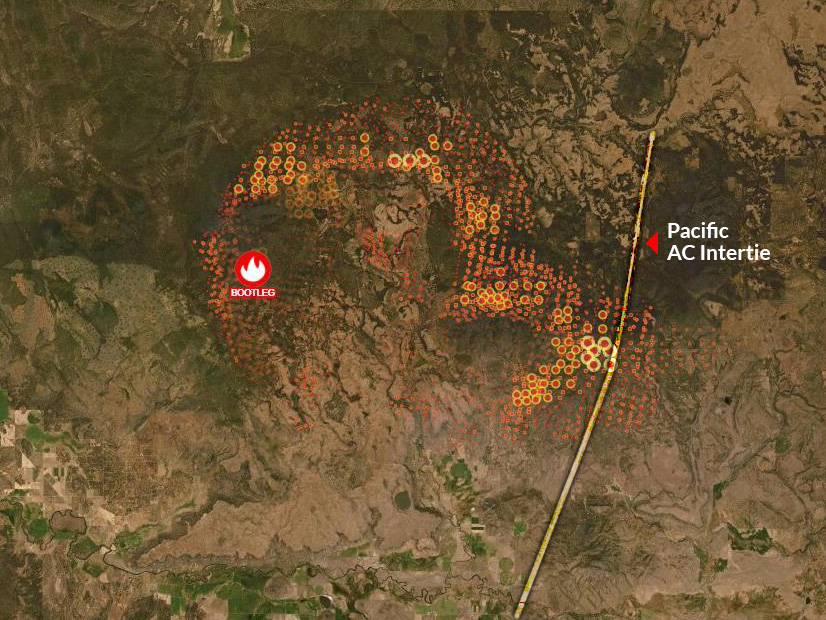CAISO declared a Stage 2 energy emergency Friday evening as an out-of-control wildfire in Oregon nearly shut down one of two major transmission pathways between California and the Pacific Northwest while significantly reducing transfer capacity on the other.
By Saturday morning, the Bootleg Fire in south-central Oregon had doubled in size to 77,000 acres and was burning under the Pacific AC Intertie (PACI), three parallel 500-kV lines that transport hydropower from Columbia River dams to population centers in California.
“Fire is on the AC Intertie right-of-way,” Bonneville Power Administration spokesman Doug Johnson told RTO Insider.
The U.S. Forest Service called the fire’s behavior “extreme.”
“The fire will continue to move unchecked in all directions, with unstable air conditions and extremely dry fuels,” it said. “Energy release components in fuels are at an all-time high.”

The 500-kV PACI lines owned by BPA, PacifiCorp and Portland General Electric, partially originate at the BPA-operated John Day Dam on the Columbia River. From there they extend south, traveling through the fire zone, and connect to the Captain Jack and Malin substations just north of the California border. The lines then split off to feed power to customers of Pacific Gas and Electric, the Western Area Power Administration and multiple municipal utilities in Northern and Central California, including the Sacramento Municipal Utility District.
BPA derated the Oregon portion of the PACI from 4,450 MW to 428 MW by 7 p.m. Friday.
Around the same time, the southbound segment of the Pacific DC Intertie (PDCI), which sends power from the Columbia River Basin to Southern California through Nevada, was derated to less than half its 3,100-MW capacity, while the northbound segment was shut down altogether. Co-owned by BPA and the Los Angeles Department of Water and Power, the PDCI cuts a similar course as the PACI through much of Oregon but lies farther to the east.
The unexpected limits on imported electricity forced CAISO to issue a grid warning and to later declare the emergency as solar power waned but demand remained high amid triple-digit temperatures in interior California.
Sacramento, for example, hit a high of 106 degrees shortly before 6 pm. Friday; the capital city’s forecasted high on Saturday is 109 degrees, the National Weather Service said.
CAISO said its initial warning indicated “that grid operators anticipate using electricity reserves [and activating] demand response programs to decrease overall demand.”
“The ISO has been requesting additional energy from its neighbors and may call upon dispatching emergency demand response programs from 6 p.m. to 8 p.m., which is the peak and net peak,” CAISO spokeswoman Vonette Fontaine said Friday. “That reduction in demand may be sufficient to avoid further emergency levels and avoid outages.”

Fire and smoke engulfed part of the Pacific AC Intertie in southern Oregon. | NOAA Esri Earthstar Geographics
At 6:32 p.m., however, CAISO suddenly skipped a Stage 1 emergency and proceeded straight to Stage 2.
The emergency announcement stated that the ISO “has taken all mitigating actions and is no longer able to provide its expected energy requirements.” CAISO avoided escalating to Stage 3, which could have led to rolling blackouts like those the ISO ordered last August amid a severe Western heat wave.
On Friday afternoon California Gov. Gavin Newsom signed an emergency proclamation to free up additional capacity, citing the loss of 4,000 MW of electricity supply.
At that time, the derate had not yet affected real-time operations of the Oregon portion of the line, BPA’s Johnson said.
But the loss of supply appeared to be driving volatility in CAISO’s real-time market, as prices at the Captain Jack and Malin nodes breached $1,000/MWh Friday evening.
At the same time, real-time prices at CAISO’s NP-15 hub — the pricing point for Northern California — spiked to about $1,035/MWh, while the southern SP-15 hub topped $990/MWh.



